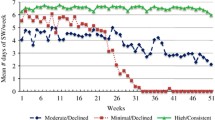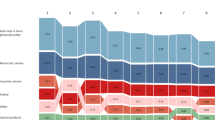Abstract
Purpose
The current study aimed to observe potential seasonal fluctuations in weight and self-weighing behavior among a diverse sample of adults engaged in a behavioral weight loss intervention.
Methods
Active duty personnel (N = 248) were randomized to either a counselor-initiated or self-paced 12-month behavioral weight loss intervention promoting daily self-weighing. Body weight and self-weighing frequency were collected from electronic scales (e-scales) provided at baseline.
Results
Overall, participants lost weight from winter to spring (p = 0.02) and gained weight from fall to winter (p < 0.001). No demographic differences in weight changes were observed. Participants self-weighed less frequently during summer compared to spring (p < 0.0001), less in fall compared to summer (p < 0.0001), and less in winter compared to fall (p < 0.0001). In multivariate models, weight change and self-weighing frequency during the previous season, as well as days since randomization and intervention intensity were associated with seasonal weight changes.
Conclusions
This study is the first to observe seasonal fluctuations of weight and self-weighing behavior among adults actively engaged in a weight loss intervention, consistent with research in the general population. Findings highlight the importance of acknowledging seasonal influence within weight loss programs and trials.
Level of evidence
Level I, randomized controlled trial.
Similar content being viewed by others
References
Ogden CL, Fryar CD, Carroll MD, Flegal KM (2004) Mean body weight, height, and body mass index, United States 1960–2002. Adv Data 347:1–17
Ma Y, Olendzki BC, Li W et al (2006) Seasonal variation in food intake, physical activity, and body weight in a predominantly overweight population. Eur J Clin Nutr 60(4):519–528. https://doi.org/10.1038/sj.ejcn.1602346
Yanovski JA, Yanovski SZ, Sovik KN, Nguyen TT, O'Neil PM, Sebring NG (2000) A prospective study of holiday weight gain. N Engl J Med 342(12):861–867. https://doi.org/10.1056/NEJM200003233421206
Sabbag C (2012) Seasonal BMI changes of rural women living in Anatolia. Int J Environ Res Public Health 9(4):1159–1170. https://doi.org/10.3390/ijerph9041159
Schoeller DA (2014) The effect of holiday weight gain on body weight. Physiol Behav 134:66–69. https://doi.org/10.1016/j.physbeh.2014.03.018
Sturm R, Patel D, Alexander E, Paramanund J (2016) Seasonal cycles in food purchases and changes in BMI among South Africans participating in a health promotion programme. Public Health Nutr 19(15):2838–2843. https://doi.org/10.1017/S1368980016000902
Lloyd L, Miller B (2013) The impact of seasonality on changes in body weight and physical activity in Mexican-American women. Women Health 53(3):262–281
Mehrang S, Helander E, Chieh A, Korhonen I (2016) Seasonal weight variation patterns in seven countries located in northern and southern hemispheres. Conf Proc IEEE Eng Med Biol Soc 2016:2475–2478. https://doi.org/10.1109/EMBC.2016.7591232
Shahar DR, Froom P, Harari G, Yerushalmi N, Lubin F, Kristal-Boneh E (1999) Changes in dietary intake account for seasonal changes in cardiovascular disease risk factors. Eur J Clin Nutr 53(5):395–400
Visscher TL, Seidell JC (2004) Time trends (1993–1997) and seasonal variation in body mass index and waist circumference in the Netherlands. Int J Obes Relat Metab Disord 28(10):1309–1316. https://doi.org/10.1038/sj.ijo.0802761
Cook CM, Subar AF, Troiano RP, Schoeller DA (2012) Relation between holiday weight gain and total energy expenditure among 40- to 69-y-old men and women (OPEN study). Am J Clin Nutr 95(3):726–731. https://doi.org/10.3945/ajcn.111.023036
Helander EE, Wansink B, Chieh A (2016) Weight gain over the holidays in three countries. N Engl J Med 375(12):1200–1202. https://doi.org/10.1056/NEJMc1602012
Stevenson JL, Krishnan S, Stoner MA, Goktas Z, Cooper JA (2013) Effects of exercise during the holiday season on changes in body weight, body composition and blood pressure. Eur J Clin Nutr 67(9):944–949. https://doi.org/10.1038/ejcn.2013.98
Hourdakis M, Papandreou D, Malindretos P, Vassilakou D, Papastergiou D, Tantsidis D, Kouvelas D (2010) Effect of Greek orthodox Easter holidays on body weight gain. Prev Nutr Food Sci 40(1):49–54. https://doi.org/10.1108/00346651011015917
Rees SG, Holman RR, Turner RC (1985) The Christmas feast. Br Med J (Clin Res Ed) 291(6511):1764–1765
Andersson I, Rossner S (1992) The Christmas factor in obesity therapy. Int J Obes Relat Metab Disord 16(12):1013–1015
Reid R, Hackett AF (1999) Changes in nutritional status in adults over Christmas 1998. J Hum Nutr Diet 12(6):513–516. https://doi.org/10.1046/j.1365-277x.1999.00205.x
Boutelle KN, Kirschenbaum DS, Baker RC, Mitchell ME (1999) How can obese weight controllers minimize weight gain during the high-risk holiday season? By self-monitoring very consistently. Health Psychol 18(4):364–368
Watras AC, Buchholz AC, Close RN, Zhang Z, Schoeller DA (2007) The role of conjugated linoleic acid in reducing body fat and preventing holiday weight gain. Int J Obes (Lond) 31(3):481–487. https://doi.org/10.1038/sj.ijo.0803437
Baker RC, Kirschenbaum DS (1998) Weight control during the holidays: highly consistent self-monitoring as a potentially useful coping mechanism. Health Psychol 17(4):367–370
Welch WA, Spring B, Phillips SM, Siddique J (2018) Moderating effects of weather-related factors on a physical activity intervention. Am J Prev Med 54(5):e83–e89. https://doi.org/10.1016/j.amepre.2018.01.025
Phelan S, Wing RR, Raynor HA, Dibello J, Nedeau K, Peng W (2008) Holiday weight management by successful weight losers and normal weight individuals. J Consult Clin Psychol 76(3):442–448. https://doi.org/10.1037/0022-006X.76.3.442
Pellegrini CA, Conroy DE, Phillips SM, Pfammatter AF, McFadden HG, Spring B (2018) Daily and seasonal influences on dietary self-monitoring using a smartphone application. J Nutr Educ Behav 50(1):56–61. https://doi.org/10.1016/j.jneb.2016.12.004
Hull HR, Hester CN, Fields DA (2006) The effect of the holiday season on body weight and composition in college students. Nutr Metab (Lond) 3:44. https://doi.org/10.1186/1743-7075-3-44
Wagner DR, Larson JN, Wengreen H (2012) Weight and body composition change over a six-week holiday period. Eat Weight Disord 17(1):e54–56
Krukowski RA, Hare ME, Talcott GW, Johnson KC, Richey PA, Kocak M et al (2015) Dissemination of the Look AHEAD intensive lifestyle intervention in the United States Air Force: study rationale, design, and methods. Contemp Clin Trials 40:232–239. https://doi.org/10.1016/j.cct.2014.12.014
Krukowski RA, Hare ME, Talcott GW, Gladney LA, Johnson KC, Richey PA, Klesges RC (2018) Dissemination of the look AHEAD intensive lifestyle intervention in the United States military: a randomized controlled trial. Obesity 26(10):1558–1565. https://doi.org/10.1002/oby.22293
Pebley K, Klesges RC, Talcott GW, Kocak M, Krukowski RA (in press) E-scale measurements in comparison to clinic weight measurements. Obesity
Shieh C, Knisley MR, Clark D, Carpenter JS (2016) Self-weighing in weight management interventions: a systematic review of literature. Obes Res Clin Pract 10(5):493–519. https://doi.org/10.1016/j.orcp.2016.01.004
Zheng Y, Klem ML, Sereika SM, Danford CA, Ewing LJ, Burke LE (2015) Self-weighing in weight management: a systematic literature review. Obesity (Silver Spring) 23(2):256–265. https://doi.org/10.1002/oby.20946
Vohs KD, Heatherton TF (2000) Self-regulatory failure: a resource-depletion approach. Psychol Sci 11(3):249–254. https://doi.org/10.1111/1467-9280.00250
Hofmann W, Rauch W, Gawronski B (2007) And deplete us not into temptation: automatic attitudes, dietary restraint, and self-regulatory resources as determinants of eating behavior. J Exp Soc Psychol 43:497–504. https://doi.org/10.1016/j.jesp.2006.05.004
Dall TM, Zhang Y, Chen YJ, Askarinam Wagner RC, Hogan PF, Fagan NK et al (2007) Cost associated with being overweight and with obesity, high alcohol consumption, and tobacco use within the military health system’s TRICARE prime-enrolled population. Am J Health Promot 22:120–139. https://doi.org/10.4278/0890-1171-22.2.120
Tanofsky-Kraff M, Sbrocco T, Theim KR, Cohen LA, Mackey ER, Stice E, Henderson JL, McCreight SJ, Bryant EJ, Stepehens MB (2013) Obesity and the US military family. Obesity 21:2205–2220. https://doi.org/10.1002/oby.20566
Acknowledgements
The research represents a Collaborative Research and Development Agreement with the United States Air Force (CRADA #13-168-SG-C13001). The study was funded by the National Institute of Diabetes and Digestive and Kidney Diseases (RO1 DK097158) of the National Institutes of Health, with the title of “Dissemination of the Look Ahead Weight Management Treatment in the Military”, Robert Klesges and Rebecca Krukowski, Principal Investigators. The trial is registered on clinicaltrials.gov (NCT 02063178). The opinions expressed in this document are solely those of the authors and do not represent an endorsement by or the views of the United States Air Force, the Department of Defense, or the United States Government. Finally, we would like to thank the participants and the research team for their dedication to the research.
Author information
Authors and Affiliations
Corresponding author
Ethics declarations
Conflict of interest
The authors declared no conflict of interest.
Ethical approval
All procedures performed in this study involving human participants were in accordance with the ethical standards of the Institutional Review Board of the 59th Medical Wing in San Antonio, Texas and with the 1964 Helsinki Declaration and its later amendments or comparable ethical standards.
Informed consent
Informed consent was obtained from all participants in the currrent study.
Additional information
Publisher's Note
Springer Nature remains neutral with regard to jurisdictional claims in published maps and institutional affiliations.
Rights and permissions
About this article
Cite this article
Fahey, M.C., Klesges, R.C., Kocak, M. et al. Seasonal fluctuations in weight and self-weighing behavior among adults in a behavioral weight loss intervention. Eat Weight Disord 25, 921–928 (2020). https://doi.org/10.1007/s40519-019-00707-7
Received:
Accepted:
Published:
Issue Date:
DOI: https://doi.org/10.1007/s40519-019-00707-7




